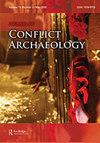过时的火枪,致命的雷明顿:1869-1877年阿根廷边境战争武器的异质性和火力
IF 0.6
0 ARCHAEOLOGY
引用次数: 7
摘要
本文研究的是1869年至1877年间阿根廷军队在边境战争中使用的火器。从两个当代军事设施- -帕斯将军堡和Fortín阿尔加罗沃斯- -收集的文献资料和考古资料结合起来,描述了那些年服役的武器装备。这是一个关键时期,在此期间,陆军武器装备的现代化和标准化进程开始了,重点是雷明顿单发后膛步枪和卡宾枪的合并。然而,考古记录表明,这个过程是缓慢的,而且种类繁多的老式火器(燧发枪、打击枪和步枪)仍在服役,造成后勤和操作问题,降低了军队的战斗力。然后,本文讨论了雷明顿枪在边境战争中的影响,批评了普遍持有的决定论特征,并将雷明顿枪的影响置于更广泛的政治和经济背景下。本文章由计算机程序翻译,如有差异,请以英文原文为准。
Obsolete Muskets, Lethal Remingtons: Heterogeneity and Firepower in Weapons of The Frontier War, Argentina, 1869–1877
Abstract This paper deals with firearms that were employed by the Argentine army in frontier warfare between 1869 and 1877. Documentary information and archaeological assemblages from two contemporary military facilities — Fort General Paz and Fortín Algarrobos — are combined to characterize the armament in service during those years. This was a crucial period, during which a process of modernisation and standardisation of the army’s armament started, centred on the incorporation of Remington single-shot breech-loading rifles and carbines. However, the archaeological record shows that this process was slow and that an astonishing variety of older firearms (flintlocks, percussion smoothbores and rifles) remained in service, causing logistic and operative problems, and reducing the army’s combat effectiveness. The paper then discusses the impact of the incorporation of the Remington guns on frontier warfare, critiquing commonly held determinist characterisations, and placing the Remington’s effect in a broader political and economic context.
求助全文
通过发布文献求助,成功后即可免费获取论文全文。
去求助
来源期刊

Journal of Conflict Archaeology
ARCHAEOLOGY-
CiteScore
0.80
自引率
50.00%
发文量
8
期刊介绍:
The Journal of Conflict Archaeology is an English-language journal devoted to the battlefield and military archaeology and other spheres of conflict archaeology, covering all periods with a worldwide scope. Additional spheres of interest will include the archaeology of industrial and popular protest; contested landscapes and monuments; nationalism and colonialism; class conflict; the origins of conflict; forensic applications in war-zones; and human rights cases. Themed issues will carry papers on current research; subject and period overviews; fieldwork and excavation reports-interim and final reports; artifact studies; scientific applications; technique evaluations; conference summaries; and book reviews.
 求助内容:
求助内容: 应助结果提醒方式:
应助结果提醒方式:


